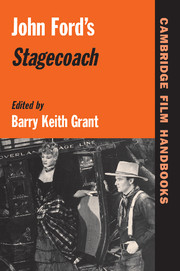Book contents
- Frontmatter
- Contents
- Acknowledgments and Credits
- List of Contributors
- Introduction: Spokes in the Wheels
- 1 Stagecoach and Hollywood's A-Western Renaissance
- 2 “Powered by a Ford”? Dudley Nichols, Authorship, and Cultural Ethos in Stagecoach
- 3 That Past, This Present: Historicizing John Ford, 1939
- 4 “A Little Bit Savage”: Stagecoach and Racial Representation
- 5 “Be a Proud, Glorified Dreg”: Class, Gender, and Frontier Democracy in Stagecoach
- 6 Stagecoach and the Quest for Selfhood
- Reviews of Stagecoach
- Filmography
- Select Bibliography
- Index
3 - That Past, This Present: Historicizing John Ford, 1939
Published online by Cambridge University Press: 08 January 2010
- Frontmatter
- Contents
- Acknowledgments and Credits
- List of Contributors
- Introduction: Spokes in the Wheels
- 1 Stagecoach and Hollywood's A-Western Renaissance
- 2 “Powered by a Ford”? Dudley Nichols, Authorship, and Cultural Ethos in Stagecoach
- 3 That Past, This Present: Historicizing John Ford, 1939
- 4 “A Little Bit Savage”: Stagecoach and Racial Representation
- 5 “Be a Proud, Glorified Dreg”: Class, Gender, and Frontier Democracy in Stagecoach
- 6 Stagecoach and the Quest for Selfhood
- Reviews of Stagecoach
- Filmography
- Select Bibliography
- Index
Summary
Though its credit sequence features a montage of leisurely movements – shots of a stagecoach and its escort moving one way; of U.S. cavalry, then Apache warriors, the other; of the stagecoach again, sans escort, as if returning – Stagecoach proper begins with riders galloping hell-bent-for-leather almost directly toward the camera, in a long shot. This shot then dissolves to an army outpost on the edge of nowhere, hitching rails to frame left, tents and camp furniture and a flag staff to frame right. A bugle blows. The stars and stripes ascend the pole in the background while the riders pass back-to-front through the frame. A more visually and dramatically central flag raising occurs at the end of Drums Along the Mohawk, another 1939 John Ford film involving frontier outposts, besieged settlers, sinister aristocrats, newborn infants, and courage tested by combat or contest. And it concludes, almost as Stagecoach begins, with a display of the national banner. Few of the Revolutionary-era characters who watch its ascent in Drums have ever seen the flag before; the symbolism of its stars and stripes must literally be explained. And individual “watchers” are picked out by Ford's camera and cutting to witness its ascent, as if they were watching on our behalf. Claudette Colbert's Lana Martin thinks the flag is “pretty”; a black woman, Daisy, Mrs.
- Type
- Chapter
- Information
- John Ford's Stagecoach , pp. 82 - 112Publisher: Cambridge University PressPrint publication year: 2002



